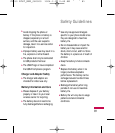
Safety Guidelines
88
exposures, since the average period
of phone use in these studies was
around three years.
5. What research is needed to
decide whether RF exposure
from wireless phones poses a
health risk?
A combination of laboratory studies
and epidemiological studies of
people actually using wireless
phones would provide some of the
data that are needed. Lifetime
animal exposure studies could be
completed in a few years. However,
very large numbers of animals
would be needed to provide reliable
proof of a cancer promoting effect if
one exists. Epidemiological studies
can provide data that is directly
applicable to human populations,
but 10 or more years follow-up may
be needed to provide answers about
some health effects, such as
cancer. This is because the interval
between the time of exposure to a
cancer-causing agent and the time
tumors develop - if they do- may be
many, many years. The
interpretation of epidemiological
studies is hampered by difficulties
in measuring actual RF exposure
during day-to-day use of wireless
phones. Many factors affect this
measurement, such as the angle at
which the phone is held, or which
model of phone is used.
6. What is the FDA doing to find
out more about the possible
health effects of wireless
phone RF?
The FDA is working with the U.S.
National Toxicology Program and
with groups of investigators around
the world to ensure that high
priority animal studies are
conducted to address important
questions about the effects of
exposure to radiofrequency energy
(RF). The FDA has been a leading
participant in the World Health
CP150 AT&T_ENG_080909 1904.3.30 2:49 AM ˘ ` 88


















